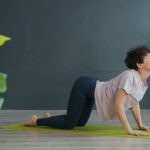Have you ever stood up from a chair and felt that little wobble in your knees? Or found yourself holding on to the railing just to feel safe going down a flight of stairs? Many people think this is just part of aging—something we all have to accept after 50.
But what if there was one simple exercise that could transform your strength, balance, and mobility without requiring gym equipment or much time?
Lunges—the move many of us avoided in gym class—turn out to be one of the most powerful tools for staying strong, steady, and mobile as we age.
This isn’t about extreme workouts or painful routines. It’s about gentle, mindful movements that deliver remarkable results.
Real-Life Leg Strength That Matters
Most people over 50 don’t care about having toned thighs or “leg day” at the gym. What really matters is practical strength: Can you get up from the floor without help? Can you carry groceries without feeling wobbly? Can you stand in the kitchen and cook a full meal without your knees begging for a break?
That’s the kind of strength lunges build—real-life functional strength that preserves your independence. After age 50, we lose up to 1-2% of muscle mass every year, especially in the lower body. This condition, called sarcopenia, quietly robs us of our independence little by little.
The good news is that lunges are one of the most efficient ways to fight back. When you do a lunge, you’re not just strengthening your quads and glutes—you’re retraining your body to stand, walk, bend, and lift with confidence. This simple move mimics the real motions we do every single day: stepping forward, kneeling down, getting in and out of chairs or cars.
The beautiful part? You don’t need to do 50 of them. Even just five to 10 lunges per leg per day can make a noticeable difference in just a few weeks. You’ll start to feel more grounded, more capable, and more like yourself again.
Balance That Keeps You Safe and Confident
Have you ever caught yourself tripping over nothing? Or reached for something on the top shelf and felt that scary moment where your body didn’t quite respond the way you thought it would? You’re not alone.
Every year in the US, over 3 million older adults are treated in emergency rooms for fall-related injuries. It’s the number one cause of injury among adults over 65. Loss of balance isn’t just about aging—it’s about neglected muscle groups and unused neural pathways.
That’s where lunges come in. Unlike static exercises, lunges force your body to stabilize in motion. One leg forward, one leg back, your brain has to engage, your core has to fire, and your foot and ankle have to stabilize every tiny shift in weight.
This isn’t just physical—it’s neurological. You’re literally training your brain and body to stay upright, respond faster, and correct small missteps before they become big falls.
Think of it like installing an internal safety net. At first, you might feel wobbly, and that’s okay—that’s your body waking up.
Over time, the shakiness fades, replaced by this subtle but powerful sense of control. Suddenly, reaching up, turning quickly, or walking on uneven ground doesn’t feel dangerous anymore. It feels doable.
Mobility That Makes You Feel Years Younger
Mobility is one of those things you don’t think much about until suddenly you do. Like the moment you try to kneel down to pick something up and realize your hips won’t let you, or when getting in and out of the car becomes an awkward two-step process.
That’s where lunges quietly shine. Every time you perform a lunge, you’re not just strengthening—you’re unlocking. You’re opening up tight hips, reactivating glutes, and gently stretching muscles that have been stiff from years of sitting, driving, or just moving less.
Mobility isn’t about being able to do the splits—it’s about freedom of movement. It’s the difference between twisting easily to check your blind spot on the road or not. It’s the ease of bending to tie your shoes without feeling like your body is resisting you.
Lunges combine dynamic stretching with functional strength. It’s not just a leg workout—it’s mobility training disguised as something simple. That’s why so many physical therapists recommend it for aging adults looking to regain fluid motion.
Metabolism and Energy Boost
If you’ve ever felt like your energy just isn’t what it used to be, you’re not imagining it. After age 50, our metabolism naturally slows down, muscle mass declines, and fat tends to stick around longer than we’d like.
But here’s the exciting news: you can influence that trend dramatically with lunges. Your metabolism isn’t controlled by your age—it’s driven largely by your muscle mass. The muscles in your legs and glutes are some of the biggest in your body, which means they have huge metabolic potential.
When you activate those muscles through daily lunges, even just a few reps at a time, you’re telling your body, “Hey, we still need this muscle. Keep it. Use it.” The result? You burn more calories at rest, your body becomes more efficient at using energy, blood sugar levels stabilize, and you start to reclaim some of that get-up-and-go energy you thought was long gone.
Leg-focused movements like lunges may even support insulin sensitivity, which is a key factor in preventing or managing type 2 diabetes—something nearly one in three adults over 50 in the US is dealing with.
How to Do Lunges Safely and Effectively
If you’ve never done a lunge before, or if the last time you tried your knees screamed at you, don’t worry. This move can be modified for any fitness level.
Step-by-step guide:
- Stand tall with your feet hip-width apart
- Take a step forward with one leg—not too far
- Slowly lower your back knee toward the ground
- Your front knee should bend naturally, staying above your ankle
- Keep your chest lifted and your core gently engaged
- If balance is an issue, place your hand on a wall or sturdy chair
- Only go down as far as feels safe—even a mini lunge counts
- Push through your front heel to return to standing
- Repeat on the other side
Start with five reps per leg, and if that feels good, gradually work up to 10. Form always matters more than depth or speed. Remember, lunges aren’t about perfection—they’re about progress.
Who Should Be Cautious With Lunges?
While lunges are safe for most people, there are some exceptions. If you’re dealing with severe knee pain, recent hip or knee surgery, or balance issues that make you feel unstable, lunges may not be the best starting point yet.
Instead, try supported or chair-based leg exercises until your strength improves. And of course, always check with your doctor or physical therapist if you’re unsure.
Remember, fitness isn’t one-size-fits-all. There’s always a path forward—we just need to find the one that fits you best.
Small Steps, Strong Future
Lunges are not just a fitness move—they’re a declaration, a simple way to say, “I still care about my strength, my balance, my freedom.” You don’t need hours at the gym; you don’t need to be an athlete. You just need to start: one lunge, one day, one act of quiet strength at a time.
You might not see a dramatic change overnight, but you will feel it in how easily you rise from a chair, how confidently you step out of the car, how steady you feel on your feet. That confidence spills into everything—you stand taller, you move more, you live more.
Try it just for one week. Five lunges a day. See how your body responds. Every lunge is a small step toward stronger legs, better balance, and a more capable you.








